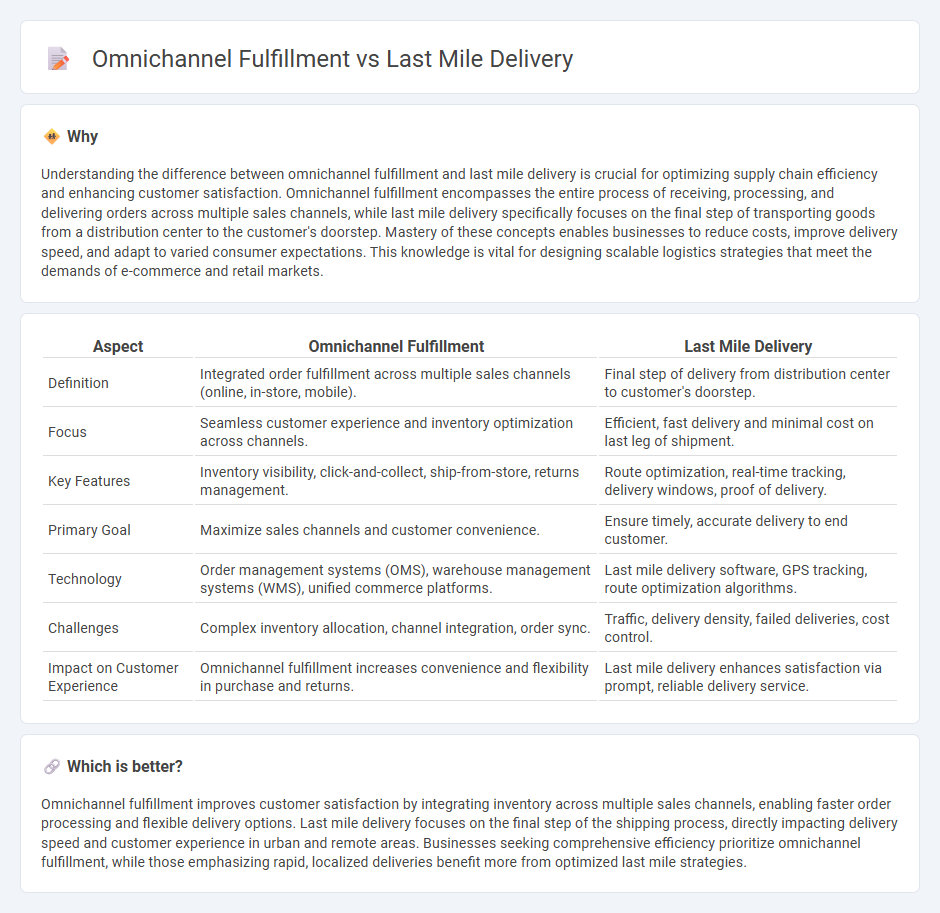
Omnichannel fulfillment integrates inventory, order management, and delivery across multiple sales channels to provide a seamless customer experience, leveraging warehouses, stores, and third-party logistics providers. Last mile delivery focuses specifically on the final step of the shipping process, ensuring products reach the consumer efficiently and cost-effectively. Explore the differences and synergies between these logistics strategies to optimize your supply chain performance.
Why it is important
Understanding the difference between omnichannel fulfillment and last mile delivery is crucial for optimizing supply chain efficiency and enhancing customer satisfaction. Omnichannel fulfillment encompasses the entire process of receiving, processing, and delivering orders across multiple sales channels, while last mile delivery specifically focuses on the final step of transporting goods from a distribution center to the customer's doorstep. Mastery of these concepts enables businesses to reduce costs, improve delivery speed, and adapt to varied consumer expectations. This knowledge is vital for designing scalable logistics strategies that meet the demands of e-commerce and retail markets.
Comparison Table
| Aspect | Omnichannel Fulfillment | Last Mile Delivery |
|---|---|---|
| Definition | Integrated order fulfillment across multiple sales channels (online, in-store, mobile). | Final step of delivery from distribution center to customer's doorstep. |
| Focus | Seamless customer experience and inventory optimization across channels. | Efficient, fast delivery and minimal cost on last leg of shipment. |
| Key Features | Inventory visibility, click-and-collect, ship-from-store, returns management. | Route optimization, real-time tracking, delivery windows, proof of delivery. |
| Primary Goal | Maximize sales channels and customer convenience. | Ensure timely, accurate delivery to end customer. |
| Technology | Order management systems (OMS), warehouse management systems (WMS), unified commerce platforms. | Last mile delivery software, GPS tracking, route optimization algorithms. |
| Challenges | Complex inventory allocation, channel integration, order sync. | Traffic, delivery density, failed deliveries, cost control. |
| Impact on Customer Experience | Omnichannel fulfillment increases convenience and flexibility in purchase and returns. | Last mile delivery enhances satisfaction via prompt, reliable delivery service. |
Which is better?
Omnichannel fulfillment improves customer satisfaction by integrating inventory across multiple sales channels, enabling faster order processing and flexible delivery options. Last mile delivery focuses on the final step of the shipping process, directly impacting delivery speed and customer experience in urban and remote areas. Businesses seeking comprehensive efficiency prioritize omnichannel fulfillment, while those emphasizing rapid, localized deliveries benefit more from optimized last mile strategies.
Connection
Omnichannel fulfillment integrates inventory and order management across multiple sales channels, ensuring seamless customer experiences by synchronizing stock availability and delivery options. Last mile delivery serves as the final step, directly influencing customer satisfaction through timely and accurate order fulfillment at the destination. The effectiveness of last mile delivery depends heavily on real-time data and coordinated logistics within the omnichannel fulfillment framework.
Key Terms
**Last Mile Delivery:**
Last mile delivery represents the final step in the supply chain, involving transporting goods from a distribution center to the customer's doorstep, crucial for customer satisfaction and time-sensitive shipments. It prioritizes speed, efficiency, and real-time tracking technologies to reduce delivery times and costs while enhancing transparency. Explore more to understand how innovative last mile delivery solutions revolutionize customer experience and operational efficiency.
Route Optimization
Route optimization in last mile delivery focuses on calculating the most efficient paths to reduce delivery time and costs, enhancing customer satisfaction by ensuring timely arrival of packages. In omnichannel fulfillment, route optimization integrates multiple sales channels and inventory locations to streamline order processing, enabling seamless delivery or pickup experiences. Explore how advanced route optimization technologies drive efficiency in both last mile delivery and omnichannel fulfillment strategies.
Proof of Delivery
Proof of Delivery (POD) plays a crucial role in last mile delivery by confirming the final recipient's receipt, enhancing transparency and customer satisfaction. In omnichannel fulfillment, POD integrates across multiple sales channels, ensuring seamless order tracking and verification regardless of the purchase source. Explore how advanced POD solutions are transforming accuracy and reliability in both delivery strategies.
Source and External Links
Last mile delivery: solutions for your business - Last mile delivery is the final leg of the item's journey from local distribution centers to the end consumer, focusing on affordable, fast, and accurate delivery via various means such as vans, bikes, or parcel lockers, with increasing emphasis on speed, reliability, and sustainability.
What is a Last Mile? Complete Guide to Last Mile Delivery ... - Last mile delivery refers to the final step bringing products directly to end users, with technology solutions like route planning and real-time driver tracking helping optimize delivery speed and efficiency to meet high customer expectations.
Last Mile Delivery Explained: Trends, Challenges, Costs & ... - The last mile problem highlights the high cost and complexity of last mile delivery, often the most expensive part of shipping, involving challenges such as short delivery windows and route optimization from local warehouses to customer delivery, with tracking and proof of delivery critical to customer satisfaction.
 dowidth.com
dowidth.com